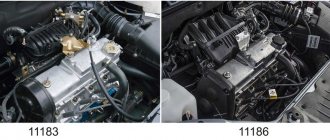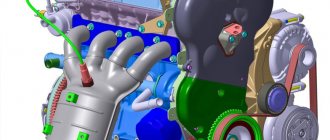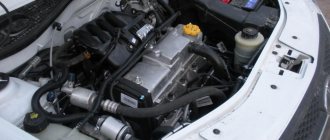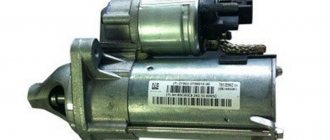The Lada Largus 8-valve engine is the most optimal and practical version of the power unit for the Russian station wagon.
At the very beginning of production, the Lada Largus was equipped with an 8-valve Renault engine. You can find this engine under the hood of a Renault Logan or Sandero. The name of this unit is K7M. Subsequently, it was decided to abandon the K7M in favor of the Russian VAZ-11189 engine.
This was done for several reasons. Firstly, the K7M engine was imported from Romania, and due to the weakening of the ruble, this power unit has increased significantly in price. Secondly, the K7M was initially weak for Largus. And due to the transition to Euro-5, it would have to be “strangled” even more, which would inevitably lead to a loss of power. In order not to completely abandon the 8-valve version of the engine for Largus, it was decided to rework the VAZ engine that had been available since the distant 80s.
What engine is Lada Largus 8 valves?
The Lada Largus engine has 8 valves and has the VAZ-11189 index. Not to say that this is a completely new engine. But a significantly modified VAZ 8-valve. Firstly, the engine was completely redesigned for the Lada Largus. Therefore, we started by completely changing the engine mounts in order to comfortably place it under the hood of a station wagon.
Next, all attachments were replaced - generator, power steering pump, air conditioning compressor. Also
The piston group was replaced and completely redesigned, which now includes lightweight connecting rods and pistons. In addition, many modifications had to be made to fit the Russian engine under the hood of the station wagon. For example, change the electrical wiring, lay hoses, change the intake and exhaust systems, move the battery and washer reservoir, etc.
Is it worth buying a Largus with a VAZ engine? Owner review
Greetings to the readers of my channel!
Since 2022, AvtoVAZ began to install VAZ 8 and 16 valve engines instead of Renault engines. The 21129 motor is now the most common; it is installed on Vesta, X-ray, and even on new Grants. But, unfortunately, it is not without its shortcomings. It was with this engine that I purchased my Largus in 2022. I will not talk about its reliability, since my mileage does not yet allow me to do this. But I can already voice those features that I don’t like or even irritate.
- Vibrations and jerking of the engine at idle speed.
The only way to combat this is with firmware. “It’s like that for everyone,” they told me at the dealer. - When starting, the engine shakes as if one of the cushions had been torn off.
Most likely the engine mounts are not selected correctly. Perhaps someone will not pay attention to this, but at first I thought it was a defect or defect. “It’s like that for everyone.” - The car does not move until 2500-3000 rpm.
. The factory firmware of the engine is designed for Euro-5 and this explains a lot. - The engine absolutely does not have enough torque up to 1500 rpm.
And this is very annoying. Crawling in a traffic jam or slowly climbing over bumps to the dacha is real hard labor. You have to constantly play with the clutch, otherwise the car starts to jerk convulsively. - Jerks and jolts when changing gears
. “It happens to everyone, it gets even worse!” — I heard it again at the dealer during the first maintenance. You have to constantly catch the moment the clutch engages in order to minimize these shocks. It's annoying. Even on my father-in-law’s old Priora, the shifts are much smoother.
But this engine is not without its advantages.
- If you turn the engine over 3000 rpm, the dynamics become quite acceptable and sufficient for this car.
Still, basically, this is more often a family or work car. - Fuel consumption.
The engine is quite economical for a car of this size. - Low engine speed in 5th gear.
Previously, this was one of the few problems of the first Largus with Renault engines. It’s just that the gears were short and on the highway in 5th gear the revolutions were under 4000, which led to increased fuel consumption and the roar of the engine in the cabin. AvtoVAZ heard the complaints and changed the gear ratio of 4th and 5th gears.
Summarize. So is it possible to take a Largus with a VAZ engine? Well, when buying a new Largus, unfortunately, you have no alternative. But when buying on the secondary market, you can choose from 4 engine options and it’s up to you to decide. If your operation is mainly on the highway and over long distances, then the 21129 motor is better suited, since there it will reveal its advantages. Moreover, all the shortcomings I listed are not entirely significant and you can get used to/adapt to them.
What is the 8-valve engine of Lada Largus 11189?
Engine 11189 is a kind of logical continuation of the VAZ-11183 engine, which you could find in cars such as Granta or Kalina. However, it has a slightly higher output of 87 hp. instead of 82 hp As I said above, this was achieved thanks to the installation of a new lightweight piston group from Federal Mogul. Of course, it was not possible to shoot 11189 of any high power, but this was not planned. The station wagon needed a simple and reliable unit that would not take the owner out of his head.
Lada Largus - now with a 16-valve VAZ engine
AvtoVAZ refused to install Renault engines on Lada Largus station wagons and vans. The Renault K4M engine was replaced by the VAZ-21129 engine - a version of the 1.6-liter sixteen-valve engine, which is known from other Ladas. Such engines are installed on almost all front-wheel drive models of the brand, including Vesta and XRAY. Thus, Lada has completely abandoned the engines of the Renault-Nissan-Mitsubishi alliance: now all cars of the Russian brand are equipped only with VAZ engines.
The VAZ sixteen-valve engine on Largus develops 106 hp. and 148 Nm versus 102 hp. and 145 Nm for the Renault K4M engine. The increase is small, but the new engine has more torque at low speeds and can legally run on AI-92 gasoline, while the French unit is required to have at least “ninety-five.” The gearbox is the same - the French five-speed manual Renault JR5, but with changed gear ratios for third, fourth and fifth gears.
Two years ago, a similar castling was carried out with the base Largus engine: an imported engine with an output of 84 hp. replaced with an eight-valve VAZ-11189 with a power of 87 hp. And then the Largus... went up in price! Although in theory, the transition to domestic engines should increase the degree of localization and reduce the cost of machines. There was no reduction in prices this time either, but now they have at least remained at the same level: a van with a 16-valve engine costs 595 thousand rubles, prices for 106-horsepower station wagons start at 620 thousand, and the Cross version is estimated at 675 thousand rubles.
Source
Engine design 8 valves Lada Lagrus
If you have ever owned a VAZ car, then you can already imagine how the 8-valve VAZ Lada Largus engine works.
This is a cast iron block that resists wear well. Aluminum cylinder head and valve cover, as well as a pan made of steel.
Number of cylinders - 4, number of valves - 8.
The timing drive, traditionally for Russian front-wheel drive cars, is belt driven. This made it possible to reduce the noise of the engine, but at the same time reduced the life of the belt. Although replacing the Lada Largus timing belt and rollers is a simple procedure that can be performed even in any garage.
There are no hydraulic compensators in this engine. Their installation would have increased the cost of the design, so the factory abandoned them. Valve clearances are adjusted using special shims. This procedure should be carried out at least once every 30 thousand kilometers. In general, such work will not hit your pocket hard, since there are plenty of specialists, and adjusting washers are available in different sizes for quite reasonable money.
The intake manifold is plastic, the exhaust has a cat manifold. The throttle is electronic.
Injection - distributed through injectors in the fuel rail.
Technical characteristics of Renault engines
| Options | Engine model | |
| RENAULT, K4M | RENAULT, K7M | |
| Injection type | Electronically controlled multipoint fuel injection | |
| Fuel type | Gasoline Premium-95 GOST 51105-97 | |
| Number and arrangement of cylinders | 4, in-line | |
| Number of valves | 16 | 8 |
| Cylinder operating order | 1-3-4-2 | |
| Direction of rotation of the crankshaft (camshaft drive side) | ||
| right | ||
| Cylinder diameter/piston stroke, mm | 79,5×80,5 | |
| Working volume, cm 3 | 1598 | |
| Compression ratio | 9,8 | 9,5 |
| Toxicity standards | Euro 4 | |
| Power at 5500 rpm, kW (hp) | — | 62 (84) |
| Power at 5750 rpm, kW (hp) | 77 (105) | — |
| Maximum torque, N.m (at rpm) | 148 (3750) | 124 (3000) |
| Volume of oil poured into the engine lubrication system, including oil filter, l | 4,8 | 3,3 |
Fuel consumption Lada Largus 8 valve engine
Another stumbling block when choosing an engine for the Lada Largus station wagon is its fuel consumption. Unfortunately, this power unit is not very economical, but it doesn’t eat too much either.
If we talk about passport data, we can see the following numbers:
City - 10.6 l / 100 km Highway - 7.6 l / 100 km Combined cycle - 8.2 l / 100 km
Yes, the numbers are not amazingly economical. But for a working station wagon they are quite adequate.
Technical characteristics of the VAZ 11189 1.6 8kl engine
| Type | in-line |
| Number of cylinders | 4 |
| Number of valves | 8 |
| Exact volume | 1596 cm³ |
| Cylinder diameter | 82 mm |
| Piston stroke | 75.6 mm |
| Supply system | injector |
| Power | 87 hp |
| Torque | 140 Nm |
| Compression ratio | 10.5 |
| Fuel type | AI-92 |
| Environmental standards | EURO 5 |
Advantages and disadvantages of the 8-valve Lada Largus engine
The main advantages of the 8-valve Lada Largus engine are its simplicity, reliability, relatively good service life, maintainability and low fuel consumption. In addition, this engine is powered by AI-92 gasoline, which will save your budget at least a little.
Among the shortcomings, I would like to note the bending of the valves when the timing belt breaks, the noisy operation of the internal combustion engine, the need to adjust the valve clearances, the low power of the internal combustion engine, as well as the frequent failure of attachments.
Technical characteristics of Renault engines
| Options | Engine model | |
| RENAULT, K4M | RENAULT, K7M | |
| Injection type | Electronically controlled multipoint fuel injection | |
| Fuel type | Gasoline Premium-95 GOST 51105-97 | |
| Number and arrangement of cylinders | 4, in-line | |
| Number of valves | 16 | 8 |
| Cylinder operating order | 1-3-4-2 | |
| Direction of rotation of the crankshaft (camshaft drive side) | ||
| right | ||
| Cylinder diameter/piston stroke, mm | 79,5×80,5 | |
| Working volume, cm 3 | 1598 | |
| Compression ratio | 9,8 | 9,5 |
| Toxicity standards | Euro 4 | |
| Power at 5500 rpm, kW (hp) | — | 62 (84) |
| Power at 5750 rpm, kW (hp) | 77 (105) | — |
| Maximum torque, N.m (at rpm) | 148 (3750) | 124 (3000) |
| Volume of oil poured into the engine lubrication system, including oil filter, l | 4,8 | 3,3 |
Oil for Lada Largus 8 valve engine
In terms of lubricant, the 8-valve Lada Largus engine is very unpretentious. You can fill in oils with a viscosity of 5W-30 / 5W-40 / 10W-40 / 15W-40. The quality of the oil must be no lower than SM according to API and no lower than GF-4 according to ILSAC. 90% of motor oils in stores meet these requirements and cost quite reasonable money.
From my personal experience I will say this: you can fill in almost any motor oil. The main thing is that it is not fake. And you need to change the oil in a timely manner - preferably after 5-7 thousand kilometers.
New VAZ 11182 engine
At the beginning of 2022, AVTOVAZ introduced a new 8-valve 1.6-liter engine (VAZ 11182 or AR16SEg2), which first appeared on the Lada Largus FL and will later appear on the Lada Granta FL.
AVTOVAZ writes that the new engine featured an updated connecting rod and piston group, a modernized crankshaft and a gas distribution mechanism. As a result, power is increased to 90 hp, and 80% of torque is available from 1000 rpm, which reduces fuel consumption and reduces shift frequency. In addition, the need to adjust valves before a mileage of 90,000 kilometers is eliminated. The engine is adapted to run on gasoline with an octane number of 92. Read more about the design in this review. Technical characteristics and reviews about it are at the link.
Let us remind you that you can read about the VAZ 21129 engine here.
Key words: Lada Largus engine
Source











